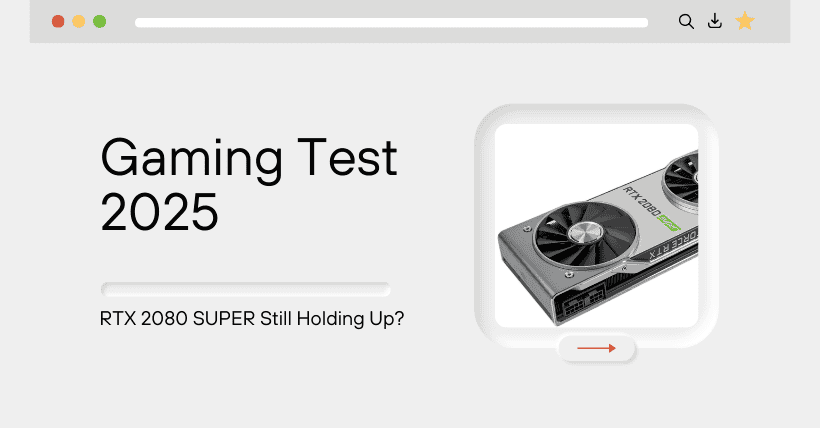01
Preface
A few days ago, we shared the latest gaming performance test of the classic veteran GeForce RTX 2080 Ti. The results showed that its performance is still very strong, capable of smoothly running most mainstream games, and it remains a worthwhile choice.
Today, we’ll be sharing the gaming performance test of its sibling model, the GeForce RTX 2080 SUPER. There is a significant difference between these two models in various aspects. How does the GeForce RTX 2080 SUPER perform now? Is it still worth buying? This article will reveal the answers for those considering purchasing a second-hand graphics card.
02
Specs Review
The GeForce RTX 2080 SUPER was released on July 23, 2019. It uses the TU104 GPU based on the Turing architecture and is manufactured with TSMC’s 12nm process. It features 3,072 CUDA cores, 192 texture units, 64 ROPs, 48 RT cores, 48 SMs, 384 Tensor cores, and 4MB of L2 cache.
The standard clock speed is 1650 MHz, with a boost clock of up to 1815 MHz. It comes with 8GB of GDDR6 video memory running at 15.5 Gbps, a 256-bit memory interface, and a memory bandwidth of 495.9GB/s. Its power consumption is 250W, and the suggested retail price was $699.
03
Test Platform Configuration
Main configuration is as follows:
Processor: Ryzen 7 7700X
Motherboard: ASUS ROG STRIX X670E-F
Memory: 32GB DDR5-6000MHz
Graphics Card: GeForce RTX 2080 SUPER
SSD: Western Digital SN850X
Operating System: Windows 11
04
Game Tests on RTX 2080 SUPER
The following tests cover seven games, all run at 1080P with maximum graphics settings.
Game 1: God of War
Average FPS: 76
Minimum Instant FPS: 71
Frame Time: 12.9ms
CPU Usage: 16%
CPU Power: 67W
CPU Temp: 73°C
RAM Usage: 14.2GB
GPU Usage: 99%
VRAM Usage: 6.4GB
GPU Power: 251W
GPU Temp: 77°C
In this game, CPU usage is around 16%, RAM usage slightly over 14GB, GPU nearly fully loaded, and VRAM usage slightly over 6GB.
Average FPS is around 80, minimum FPS around 70, frame time around 13ms. Runs smoothly with no weaknesses.
Game 2: Spider-Man
Average FPS: 51
Minimum Instant FPS: 33
Frame Time: 18.8ms
CPU Usage: 33%
CPU Power: 73W
CPU Temp: 82°C
RAM Usage: 16.9GB
GPU Usage: 98%
VRAM Usage: 7.3GB
GPU Power: 196W
GPU Temp: 69°C
CPU usage is around 33%, RAM around 17GB, GPU nearly fully loaded, VRAM usage slightly over 7GB.
Average FPS is around 50, minimum around 30, frame time around 18ms. Performance is lower than the previous game but still runs smoothly.
Game 3: Horizon Forbidden West
Average FPS: 64
Minimum Instant FPS: 52
Frame Time: 13.9ms
CPU Usage: 42%
CPU Power: 81W
CPU Temp: 94°C
RAM Usage: 13.1GB
GPU Usage: 97%
VRAM Usage: 6.8GB
GPU Power: 236W
GPU Temp: 69°C
CPU usage around 40%, RAM around 13GB, GPU nearly fully loaded, VRAM around 7GB.
Average FPS is over 60, minimum around 50, frame time around 13ms. Runs smoothly with ease.
Game 4: Call of Duty: Black Ops 6
Average FPS: 83
Minimum Instant FPS: 67
Frame Time: 13.5ms
CPU Usage: 19%
CPU Power: 64W
CPU Temp: 73°C
RAM Usage: 11.6GB
GPU Usage: 99%
VRAM Usage: 7.4GB
GPU Power: 222W
GPU Temp: 72°C
CPU usage around 20%, RAM between 11GB–12GB, GPU nearly fully loaded, VRAM slightly over 7GB.
Average FPS around 80, minimum over 60, frame time around 13ms. Runs very smoothly.
Game 5: Black Myth: Wukong
Average FPS: 39
Minimum Instant FPS: 36
Frame Time: 25.3ms
CPU Usage: 11%
CPU Power: 53W
CPU Temp: 68°C
RAM Usage: 12.1GB
GPU Usage: 98%
VRAM Usage: 7.0GB
GPU Power: 244W
GPU Temp: 76°C
CPU usage around 10%, RAM around 12GB, GPU nearly fully loaded, VRAM around 7.0GB.
Average FPS around 40, minimum around 30, frame time around 25ms. Latency is high, smoothness is lacking.
Game 6: Warhammer 40K: Space Marine II
Average FPS: 71
Minimum Instant FPS: 63
Frame Time: 13.9ms
CPU Usage: 30%
CPU Power: 77W
CPU Temp: 82°C
RAM Usage: 15.4GB
GPU Usage: 98%
VRAM Usage: 6.1GB
GPU Power: 246W
GPU Temp: 75°C
CPU usage around 30%, RAM just over 15GB, GPU nearly fully loaded, VRAM around 6GB.
Average FPS around 70, minimum around 60, frame time around 13ms. Runs smoothly with no issues.
Game 7: The Last of Us
Average FPS: 43
Minimum Instant FPS: 33
Frame Time: 24.7ms
CPU Usage: 27%
CPU Power: 73W
CPU Temp: 85°C
RAM Usage: 20.0GB
GPU Usage: 99%
VRAM Usage: 7.4GB
GPU Power: 203W
GPU Temp: 69°C
CPU usage around 30%, RAM around 20GB, GPU nearly fully loaded, VRAM slightly over 7GB.
Average FPS around 40, minimum around 30, frame time around 24ms. Latency is high, smoothness is limited.
05
Test Conclusio
Overall, the performance of the GeForce RTX 2080 SUPER is still solid, capable of smoothly running most light to mid-tier games, but it struggles with heavy AAA titles and shows its limitations.
In this case, whether the GeForce RTX 2080 SUPER is worth buying mainly depends on actual needs. If your requirements aren’t high and you only plan to play light to mid-tier games, it’s a viable option. However, if you have higher demands, its performance becomes a bit inadequate, and it’s not recommended.

Disclaimer: This article is created by the original author. The content of the article represents their personal opinions. Our reposting is only for sharing and discussion purposes and does not imply our endorsement or agreement. If you have any objections, please get in touch with us through the provided channels.



